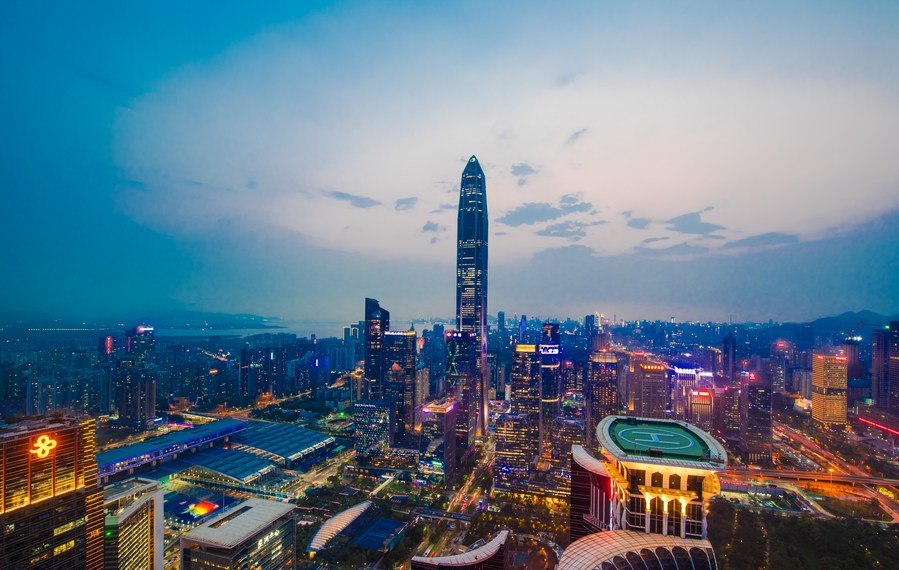
Photo taken on March 19, 2019 shows the view of the Central Business District (CBD) in Shenzhen, south China's Guangdong Province. (Xinhua/Mao Siqian)
BEIJING, July 14 (Xinhua) -- China's consumer price index (CPI), a main gauge of inflation, rose 2.5 percent year on year in June, when producer price index (PPI), which measures costs for goods at the factory gate, went up 6.1 percent year on year, according to recent statistics from the National Bureau of Statistics (NBS).
The CPI figure is an indication that the overall situation of China's epidemic control has been improved in June, featured with sufficient supply of important livelihood commodities and generally stable consumer prices, according to Dong Lijuan, a senior statistician with the NBS.
The PPI figure in June shows the continuous resumption of work and production, along with gradual recovery of supply and industrial chains in key sectors, said Dong, noting that measures for securing supply and stabilizing price have been taking effect.
-- Numbers show sign of policy package paying off
The State Council unveiled 33 measures in six fields to stabilize the economy in May, followed by proactive responses from local authorities with series of specific measures that effectively improved market confidence.
It is evident that both supply and demand sides in the manufacturing industry has been recovering in China, said Cheng Qiang, analyst with CITIC Securities. As more sectors and enterprises are getting back on track when transportation and logistics are being improved, it is potential that the PMI will continue to grow in the future.
The performance in the logistics sector is another sign of the recovering economy. In the first half (H1) of this year, China's express delivery companies handled a total of 51.22 billion parcels, up 3.7 percent year on year. Their business revenue amounted to 498.22 billion yuan (about 74.14 billion U.S. dollars), up 2.9 percent year on year, according to the State Post Bureau of China.
Besides, the index tracking China's logistics market performance stood at 52.1 percent in June, up 2.8 percentage points from the previous month and climbing above 50 percent for the first time in three months, according to the China Federation of Logistics & Purchasing (CFLP).
The figure reflects the active performance from both sides of supply and demand, thanks to the constant effect of the policy package, said He Hui, assistant president of the CFLP. It is expected that with future release of demand and acceleration of production, the logistics sector will recover to a more active level, He said.
The core CPI, which excludes food and energy prices, rose 1 percent year on year in June. The increase gain was 0.1 percentage points higher than the previous month. Analysts at Guotai Junan Securities believe that this shows the preliminary signs of recovery in consumption, especially offline service consumption.
Recovery in the service sector has also been proved by relative data. The business activity index of the service industry bounced back to 54.3 percent, up 7.2 percentage points from the previous month, according to statistics from the NBS.
-- Steering investment, consumption keys to growth momentum
Despite the still considerable uncertainties in the external environment in the second half of this year, the fundamentals of China's long-term economic growth remain unchanged, thanks to large-scale domestics market, the integrated industrial and supply chains, as well as the rapid development in sci-tech innovation, according to the Bank of China Research Institute.
Experts believe that expanding effective investment and promoting consumption recovery will play key roles in stabilizing the economy in the second half of this year. At the same time, measures for stabilizing employment should continue to be implemented in a bid to enhance market confidence in a constant manner.
Investment in infrastructure is not only a key to stabilize investment, but an effective tool to promote growth and boost demand, said Chen Li, a chief economist with Chuancai Securities, predicting that infrastructure investment will show further resilience in the second half of this year.
Chief analyst at CITIC Securities Ming Ming pointed out that attentions should be paid to expanding investment in manufacturing and real estate industry. By continuing to strengthen fiscal and financial support for the manufacturing industry and encourage technological innovation, it is expected to forge favorable conditions for the expansion of manufacturing investment in the second half of the year, Ming said.
In terms of promoting the recovery of consumption, an important driving force would be the release of comprehensive consumption potential through targeted supporting policies, new consumption models and preferential treatment for major sectors including automobile, according to Ming.
Stabilizing consumer demand is conducive to long-term sustainable development of China's economy, said Teng Tai, director of WANB Institute, a think tank. It is crucial to promote further recovery of the service sector and increase marginal consumption tendency of residents in the second half of 2022, Teng said.
The essence of fueling consumption is to make sure that people dare to spend their money, which underlines the importance of stabilizing employment while rolling out favorable policies and effective measures to bail out companies facing difficulties, according to Chen.
Ming agrees that it is important to promote employment through reducing financial burdens on enterprises, adding that specific measures include encouraging college students to start their own businesses, increasing the employment of rural migrant workers in cities through construction projects, providing adequate career services and basic guarantees, as well as including employment stabilization as an indicator for government performance assessment, in a bid to encourage solid efforts by local governments.
(Edited by Yu Huichen with Xinhua Silk Road, yhc0267@163.com)




 A single purchase
A single purchase









